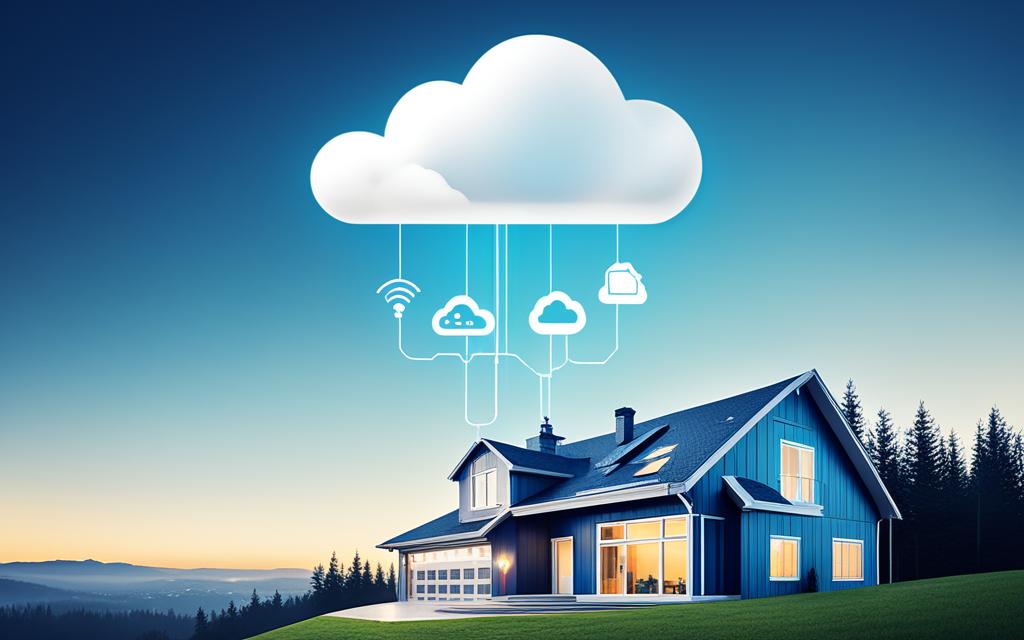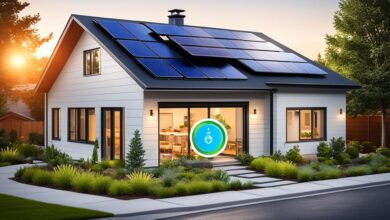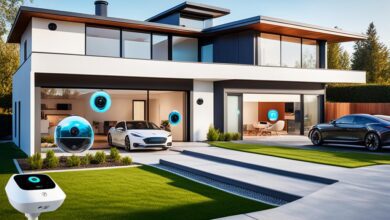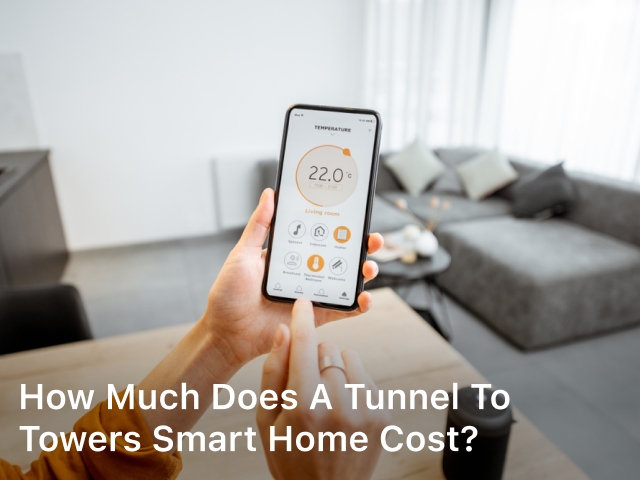
In today’s world, having a “smart home” is common. A home automation system lets you control your house’s features and items easily. It links all your connected devices so you can manage things like lights, heating, security from your phone or with voice assistants. This makes your home more convenient and saves energy.
It’s all part of the Internet of Things (IoT) trend. This means your devices at home can connect to the internet and can be controlled anywhere. Having a home automation system makes things easier and smarter. It brings better convenience, saves energy, makes your home safer, and lets you control everything from afar. This lets you live more intelligently, with many tasks happening automatically.
Introduction to Home Automation Systems
Home automation, commonly known as “smart home” tech, uses internet-connected devices to oversee functions in a home. It lets homeowners automate and manage various features like appliances and lighting remotely. The aim is to boost convenience, save energy, and enhance safety by connecting smart devices.
Defining Home Automation
Home automation makes use of IoT to link smart devices and create a smart living space. This allows for easy control via voice, apps, or a central hub. It’s all about making your home smarter and more efficient.
Benefits of Home Automation
Having a home automation system brings several advantages:
- Convenience: Homeowners can control household tasks from anywhere, like turning on lights and adjusting heat, using their phone or voice assistant.
- Energy efficiency: Smart devices can adjust for your habits, saving energy and money by managing things like the thermostat or lights.
- Enhanced security: With smart cameras and locks, you can watch over and protect your home, even from far away.
- Remote access: It allows you to check and control your home from any location, offering peace of mind when you’re away.
Home automation improves daily life through these key features. It makes homes more pleasant, efficient, and secure for everyone.
Components of a Home Automation System
Home automation runs on the Internet of Things (IoT). This is a network where physical devices and gadgets connect to the internet. They can talk to each other.
In a home, IoT devices mean smart lights, thermostats, security cameras, and more. These gadgets can be managed without being there. You can use apps, talk to your device, or have a central hub to control them.
Control Protocols (Wi-Fi, Zigbee, Z-Wave, etc.)
For a smart home to work, it needs communication rules. Wi-Fi connects devices to the internet for direct control and monitoring. Zigbee and Z-Wave, on the other hand, work without using your home’s Wi-Fi. This is good for saving energy.
- Wi-Fi: Lets smart tech connect to the internet at home. It means you can control and check them with special apps and your voice.
- Zigbee and Z-Wave: These are special ways smart gadgets talk to each other without bothering your Wi-Fi.
- Bluetooth: It’s for sending signals close by between smart devices.
- Thread: A new way that makes smart devices work together better and safer.
Smart Home Hub
The heart of a smart home is the smart home hub. It links and controls all the smart devices at home. This hub joins with your Wi-Fi network. And, it lets you watch and manage your smart home from one place. Devices like Amazon Echo, Google Home, and Apple HomeKit are popular.
They let you order your lights, adjust the temperature, check on your security, and more. You can do this with your voice, on your phone, or using a website.
Smart Home Devices and Appliances
Smart home technology covers a wide range of devices and appliances. It includes things like smart lighting, thermostats, security systems, and entertainment setups. These innovations aim to make life easier, save energy, and improve how homes are managed.
Smart Lighting and Thermostats
Smart lights and thermostats are big in the smart home world. They can be controlled by your phone or set to turn on and off automatically. This saves energy and adjusts your home to the right temperature without you having to do anything.
Smart Security and Surveillance
Smart homes also offer advanced security and monitoring features. Systems with cameras, sensors, and locks can be managed from anywhere. Video doorbells and security cameras let you check on your home no matter where you are.
Smart Appliances and Home Entertainment
More smart devices include refrigerators, ovens, and washing machines. You can manage these appliances from a distance and some even get updates. TVs and speakers can also be connected to streaming services and work together with other smart home gadgets for a fun experience.
Voice Assistants and Remote Control
Today, voice assistants are key in making homes smarter. They let us control our devices just by talking. The top voice assistants for smart homes are:
Amazon Alexa
Alexa is Amazon’s smart aide, found in Echo and more devices. You can ask Alexa to do many things in your home. It works with lights, thermostats, security, and more.
Google Assistant
Google’s assistant is on Google Nest devices. It helps you control smart home gadgets with your voice. You can also ask it questions and do other tasks.
Apple Siri
Siri is Apple’s assistant for iPhones and iPads. It’s not as widely integrated with smart home devices, but it works well with Apple’s HomeKit products. If you use Apple devices, you can control your smart home with Siri.
Cloud Computing and Home Automation
Home automation systems often use cloud computing. This lets users access data remotely and store it. Instead of needing a separate computer at home, all data is stored on the internet. This means you can control your home from anywhere and add more devices easily.
With cloud computing, your system can update on its own. You can also watch camera footage from anywhere. But, using the cloud for your home comes with some security risks. It’s important to protect your data.
Adding the cloud to home automation makes everything so much easier. You can get to your devices from anywhere and store a lot of data. Plus, you can keep adding new gadgets to your smart home as you want. This way, you get more control and freedom with your home tech.

Home Automation Protocols and Standards
Getting a smooth smart home setup means making sure devices, systems, and standards work together. Zigbee, Z-Wave, and the Matter standard are key here.
Zigbee
Zigbee is a top wireless protocol for smart homes. It uses a network setup where devices connect directly. This setup improves reliability. Devices using Zigbee can also save more power, which is great for gadgets running on batteries. Plus, Zigbee helps different brands work together smoothly.
Z-Wave
Like Zigbee, Z-Wave is a favorite for making smart homes smarter. It connects devices in a similar way but uses a different frequency, helping devices talk to each other from farther away. Z-Wave also uses less power. Even though Zigbee and Z-Wave do similar things, they don’t naturally talk to each other without help. You might need to pick one or use a special hub for both.
Matter (New Smart Home Standard)
Matter joined the scene in 2022 to level up smart home device chat. It’s a standard created by the Connectivity Standards Alliance. Matter aims to end the struggle of getting devices from different brands to work together. Unlike some older players, Matter is open and uses familiar Wi-Fi. This makes managing your smart home, no matter the brand, much easier.
what is a home automation system
A home automation system, also called a smart home system, is a set of connected electronic devices at home. These devices can be controlled and monitored from a distance. It lets homeowners manage lighting, temperature, security, and entertainment through a central control. They can use a smartphone app or voice commands.
This system includes IoT devices, a central hub, and ways for the devices to talk to each other. Home automation brings together smart technology to make life easier and save energy. It uses the Internet of Things (IoT) to create a home that adapts to the owner’s needs.
The system is powered by IoT devices like smart lights, thermostats, cameras, and appliances. These devices can talk to each other and are controlled from a central hub. This setup makes the home smart. It helps homeowners automate and keep an eye on home tasks easily and efficiently.
Setting Up a Smart Home
Building a smart home lets homeowners choose between wireless and hardwired automation. Each has its benefits and considerations.
Wireless vs. Hardwired Systems
Wireless systems are easier to set up because they don’t need lots of wires. They connect to the Wi-Fi so you can control things with your phone or a voice assistant. But, they might need good Wi-Fi to work well.
Hardwired systems are known for being very reliable and safe. They are part of the home’s wiring which makes them very secure. They are great for new homes or big renovations. But, they cost more to install because of the work involved.
DIY vs. Professional Installation
Homeowners can choose to set up their smart home by themselves or with a professional. Doing it yourself means buying and putting in smart devices on your own. It’s cheaper, but needs some tech knowledge.
Having a pro do it means a flawless smart home with advanced systems. They help with choosing the right devices, connecting everything, and maintaining it. Yet, it costs more to start with.
| Wireless Systems | Hardwired Systems |
|---|---|
|
|
| DIY Setup | Professional Installation |
|---|---|
|
|
Advantages and Disadvantages of Home Automation
Home automation makes our lives easier in many ways. But, it has its own set of challenges too. Let’s look at the main good and bad points of having this technology in your home.
Pros (Convenience, Energy Efficiency, Safety)
Home automation boosts convenience by letting us control our home remotely. We can change the lights, adjust the temperature, and more, all from our phone. This makes our living space suit our needs better, improving our daily life.
It also helps save on our energy bills. Smart devices at home can adjust their settings based on when you’re home, your schedule, and the weather. This smart management of energy can save you money and help the planet too.
Home automation makes our houses safer and more secure too. With smart locks, motion detectors, and cameras, your home is better protected. It brings peace of mind, whether you’re in or out of the house.
Cons (Cost, Security Concerns, Complexity)
Yet, there are issues worth noting. First, the initial cost of setting up a smart home can be quite high. Buying the devices, sensors, and installation can be a big expense. This might stop some from jumping into automation.
Another worry is cybersecurity. Connecting so many devices to the internet can create a risk of being hacked. To keep your home safe, it’s vital to use strong security and keep everything up-to-date.
Finally, setting up and managing all these smart devices can be tough. It takes time and effort, especially for those who aren’t very tech-savvy. Managing a smart home needs learning and adapting to new tech regularly.
When considering home automation, think about what’s important to you. Consider your budget and how comfortable you are with tech. This will help you decide if home automation is right for you and your family.
Smart Home Integration and Interoperability
To make our smart home run smoothly, we need to connect all its parts. This includes devices, software, and how they talk to each other. Homeowners must choose products that all work well together to avoid any headaches.
New standards such as Matter make it easier for different devices to understand each other. So, you can pick your favorite brands and mix their products. But, to get everything running perfectly, you need to plan and do your homework.
| Factors to Consider | Importance for Smart Home Integration |
|---|---|
| Device Compatibility | It’s key that devices from various brands can talk to each other smoothly. This ensures your smart home works as one. |
| Platform Integration | Connecting all your devices to one main system means easier control. It improves how you manage your smart home. |
| Communication Protocols | The right way for your devices to communicate is very important. This includes options like Wi-Fi, Zigbee, and Z-Wave. |
Understanding and focusing on these factors builds a smart home that’s fully cohesive. Every device and system work together perfectly, offering the best in ease, efficiency, and control.
Conclusion
Home automation systems have really advanced in recent years. They turn regular homes into smart, connected spaces. They use the Internet of Things (IoT) to let homeowners control many functions, like lights and security, from one place.
These systems offer better convenience, save energy, and make homes safer. This is why many people like them. But, there are issues too. Things like cost, security worries, and how complex they can be slow down their use.
Still, as tech gets better, so will home automation. We’ll see systems that work better together and are safer. The future smart home will offer more convenience and control, changing how we use and take care of our homes.




